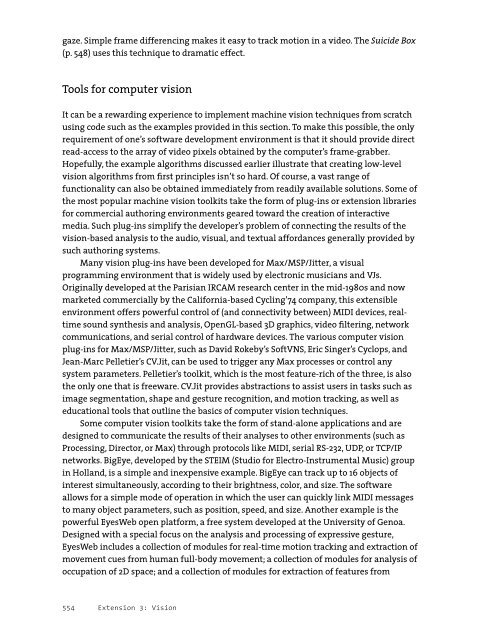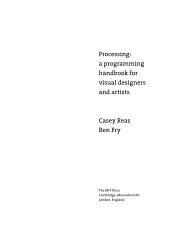Fractal.Invaders, Substrate (Interview with Jared Tarbell) - Processing
Fractal.Invaders, Substrate (Interview with Jared Tarbell) - Processing
Fractal.Invaders, Substrate (Interview with Jared Tarbell) - Processing
You also want an ePaper? Increase the reach of your titles
YUMPU automatically turns print PDFs into web optimized ePapers that Google loves.
gaze. Simple frame differencing makes it easy to track motion in a video. The Suicide Box<br />
(p. 548) uses this technique to dramatic effect.<br />
Tools for computer vision<br />
It can be a rewarding experience to implement machine vision techniques from scratch<br />
using code such as the examples provided in this section. To make this possible, the only<br />
requirement of one’s software development environment is that it should provide direct<br />
read-access to the array of video pixels obtained by the computer’s frame-grabber.<br />
Hopefully, the example algorithms discussed earlier illustrate that creating low-level<br />
vision algorithms from fi rst principles isn’t so hard. Of course, a vast range of<br />
functionality can also be obtained immediately from readily available solutions. Some of<br />
the most popular machine vision toolkits take the form of plug-ins or extension libraries<br />
for commercial authoring environments geared toward the creation of interactive<br />
media. Such plug-ins simplify the developer’s problem of connecting the results of the<br />
vision-based analysis to the audio, visual, and textual affordances generally provided by<br />
such authoring systems.<br />
Many vision plug-ins have been developed for Max/MSP/Jitter, a visual<br />
programming environment that is widely used by electronic musicians and VJs.<br />
Originally developed at the Parisian IRCAM research center in the mid-1980s and now<br />
marketed commercially by the California-based Cycling’74 company, this extensible<br />
environment offers powerful control of (and connectivity between) MIDI devices, realtime<br />
sound synthesis and analysis, OpenGL-based 3D graphics, video fi ltering, network<br />
communications, and serial control of hardware devices. The various computer vision<br />
plug-ins for Max/MSP/Jitter, such as David Rokeby’s SoftVNS, Eric Singer’s Cyclops, and<br />
Jean-Marc Pelletier’s CV.Jit, can be used to trigger any Max processes or control any<br />
system parameters. Pelletier’s toolkit, which is the most feature-rich of the three, is also<br />
the only one that is freeware. CV.Jit provides abstractions to assist users in tasks such as<br />
image segmentation, shape and gesture recognition, and motion tracking, as well as<br />
educational tools that outline the basics of computer vision techniques.<br />
Some computer vision toolkits take the form of stand-alone applications and are<br />
designed to communicate the results of their analyses to other environments (such as<br />
<strong>Processing</strong>, Director, or Max) through protocols like MIDI, serial RS-232, UDP, or TCP/IP<br />
networks. BigEye, developed by the STEIM (Studio for Electro-Instrumental Music) group<br />
in Holland, is a simple and inexpensive example. BigEye can track up to 16 objects of<br />
interest simultaneously, according to their brightness, color, and size. The software<br />
allows for a simple mode of operation in which the user can quickly link MIDI messages<br />
to many object parameters, such as position, speed, and size. Another example is the<br />
powerful EyesWeb open platform, a free system developed at the University of Genoa.<br />
Designed <strong>with</strong> a special focus on the analysis and processing of expressive gesture,<br />
EyesWeb includes a collection of modules for real-time motion tracking and extraction of<br />
movement cues from human full-body movement; a collection of modules for analysis of<br />
occupation of 2D space; and a collection of modules for extraction of features from<br />
554 Extension 3: Vision



